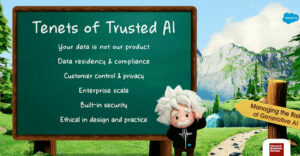
In our careers as consumers, we’ve all encountered employees from time to time who display a shocking lack of manners, aggressive ignorance of what their company sells, or a toxic attitude that suggests we’re seen as an enemy rather than a customer.
“How in the world did this person get this job?” we might ask as we hang up the phone or flee the store. “And how in the world is this person allowed to keep this job?”
One of the great parts of the social media revolution is the impact it’s having on these sorts of employees and the experiences they create for customers. In the past, we might walk away from our encounters with them with a story to share with a few of our friends. Today, we have the ability to broadcast the story to the entire world, and it can be heard by anyone who does a Google search for a business’ name. The customer controls the conversation, and that conversation can deliver a pretty nasty payback.
Nowhere to Hide
I’ve said in the past that CRM starts with hiring. No matter what kind of technology you invest in, the wrong employees will sabotage your efforts and cause the best intentions of everyone involved — sales, marketing and support — to result in a big bust. Social media amplifies this phenomenon.
Not only can one person wreck your efforts to build loyalty and brand awareness — one person can wreck it in a spectacular and embarrassingly public way. And it may not be someone in-house, either. As a case in point, see this story about a disastrous and self-destructive series of responses to a service issue that went viral in the gaming community, thanks to a PR contractor.
While you may be able to laugh it off, the reality is that the exceptional behavior of that one employee is likely to stick in your customers’ heads with greater tenacity than all the positive actions of the rest of your staff combined. That’s not because customers are vindictive — that’s just the way the human brain works.
Don’t think that you can hide misanthropic employees in the back office. The realities of business today mean that at some point, a customer may deal with someone in finance, or in your warehouse, or deep in engineering. If the customers don’t deal with them directly, they’re likely to have a negative impact on other employees in customer-facing roles with delayed responses, partial information and less than complete service advice.
So, how do you cope with this new social media world in which every employee can potentially be singled as a representative of your entire business? First, your business needs to realize that building customer relationships is what the business is about — it is, as we used to say in the navy, an all-hands evolution. That means that HR and recruiting needs to comprehend fully how important a customer-centric attitude is for every employee.
It Cuts Both Ways
Of course, customer-facing employees need to be friendly, helpful and customer-centric, but the entire organization must be built on the idea that regardless of your role and no matter how deep you’re buried in the organization, your job ultimately involves taking care of the customer.
Next, management has to realize that the way it behaves will either enhance or quash those tendencies in the employees. Are you setting up processes that force employees to work for the process instead of the customer? If you are, stop it. Are your managers bullying employees or treating them uncivilly? Then why would you expect those employees to treat customers well?
Finally, have you made it clear to employees the impact their bad behavior can have, thanks to social media, both to the company and to their own career paths? Becoming known as the abrasive, insulting boor from that story that 3 million people saw via social media is a great way to destroy your resume.
Alternately, belonging to an organization that has customers talking about it in glowing terms is great for everyone — the business, the employees and the customers. Let your employees know that positive commentary will be rewarded and that social media is a barometer to gauge their success in building loyalty and brand value.























































Great article Mr. Bucholtz, businesses need to remind that to achieve the way of success they need to turn into a customer-centric policy. Customers are the engine of the core business for companies. Today, the Innovation Technology, with social networks and crowdsourcing can help us to join users and customers more easily, making them more satisfied and loyal, or better, companies can improve their customer performance with crowdsourcing and social networks saving money! I love Innovation Technology..
The Internet and social media are great tools for both the consumers and companies. For the companies, something like a Twitter gives them new ways to interact with their customers and to address concerns.
From the customer perspective, it also gives them the chance to sound off if a company’s PR team has been less than satisfactory. Companies need to be more careful than ever about who they are putting in charge of customer service and public relations since these people are often the voice of the company. Hiring the right people and providing a happy work environment will go a long way in maintaining good service and brand loyalty AM ong customers.
Sarah
Mosaic Technology